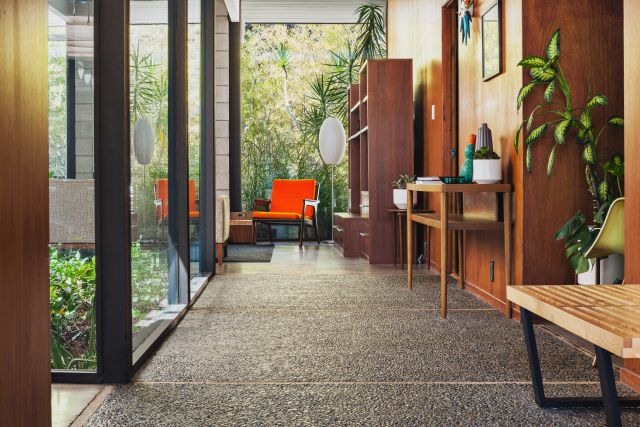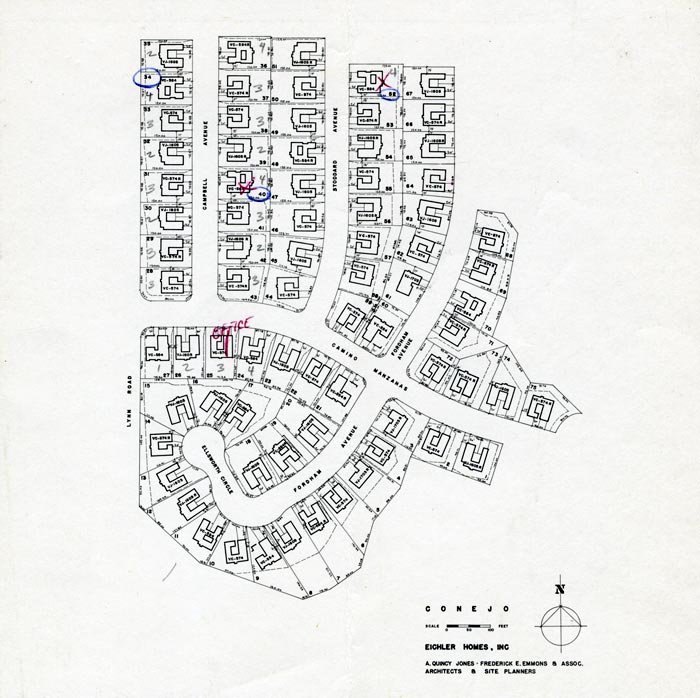
Thousand Oaks Eichlers Open for Tours
 |
|
|
For Eichler fans in Northern California, Thousand Oaks may seem a remote spot to find a neighborhood of Eichlers.
While most Eichlers can be found in the Bay Area, Southern California does have its tracts too. But the better known ones are a trio in the city of Orange, and Balboa Highlands in the northern reaches of Los Angeles.
But the Conejo Valley area of Thousand Oaks in Ventura County, northwest of Los Angeles, has about 100 Eichlers. The people who live in them love them -- and, through the auspices of the Society of Architectural Historians, Southern California Chapter, are anxious to show them off.
The tour happens on Saturday May 13. It will be the first time homes in the neighborhood have been open to touring by outsiders, says Merry Ovnick, the tour’s point person. Tickets can be purchased through the society’s events page. For information, check the website or call 1-800-972-4722.
 |
|
|
It commences at the Thousand Oaks Library with a talk by Paul Adamson about Eichler and about the neighborhood itself. Adamson is the author of ‘Eichler: Modernism Rebuilds the American Dream,’ which was compiled by Marty Arbunich, publisher and managing editor of CA-Modern and the Eichler Network.
Following the talk, several homes will be open for inspection, each manned by docents. Advance ticket holders will be given an order in which to visit the homes, to avoid traffic jams, says Ovnick, an architectural historian and editor.
This is clearly the season for Eichler home tours. Just a week before, on May 6 and May 7, fans can enjoy the long-running San Mateo Highlands Eichler Home Tour.
Ovnick gives some background about the Thousand Oaks neighborhood, which was constructed not long before before Eichler Homes went bankrupt. (Eichler returned to homebuilding after bankruptcy, working as a smaller operation. His ventures in Southern California, and his large projects in San Francisco, in part led to the financial mess.)
“The Conejo Valley Eichler Homes were built in 1963-'64,” Ovick writes. “In 1966, a group of Beverly Hills investors headed by Charles H. Parr, Sr. acquired control of Eichler Homes, forming two new corporations: Eichler Properties, Inc. (property management) and Eichler Financial Corp. By 1967 the new companies were advertising ‘Lenders Close-Out.’”
 |
|
|
Although the Thousand Oaks tract is remote from other Eichler neighborhoods, its residents fully get into the Eichler experience. They do Halloween up big in the neighborhood, and threw a lively birthday party on the occasion of the tracts 50th anniversary.
And, to let the outside world know that the tract exists, and that it might be worth an admiring look, several years back some residents installed an ‘Eichler’ sign to catch the attention of motorists speeding by.
Ovnick says the society is looking forward to the tour because “mid-century modernism is the heart of what we do.” She recalls that the society did a previous Eichler tour, down in Orange back in 2001, when ‘Modernism Rebuilds the American Dream’ had just been published.
Ovnick says the tour hopes to have open homes that represent each of the four models that can be found in the tract.
In choosing homes for the tour, she says, “We are looking at the flow-through of the house, the clean lines, and its landscaping also.”
 |
|
|
She notes that the recent drought damaged much landscaping, and says many people have installed drought-tolerant yards, showing how that could be done “in the spirit of an Eichler.”
“I have been most impressed with how well kept these houses are,” she says. “You can look up and down the street and it looks just as it was planned by Joe Eichler. The homes all look intact. There are no McMansions.”
“People are really proud of their houses. I spoke to one woman who has been in her house for 30 years. It’s the way it always was, even with the Philippine mahogany.”
She adds: “My personal interest has been in the livability factor. What was ideal for families and their lifestyle in the 1960s was very different than for today’s white-collar family. But I’m impressed with how well [Eichlers] have adapted to today’s living environment. Wonderfully.”
- ‹ previous
- 585 of 677
- next ›



